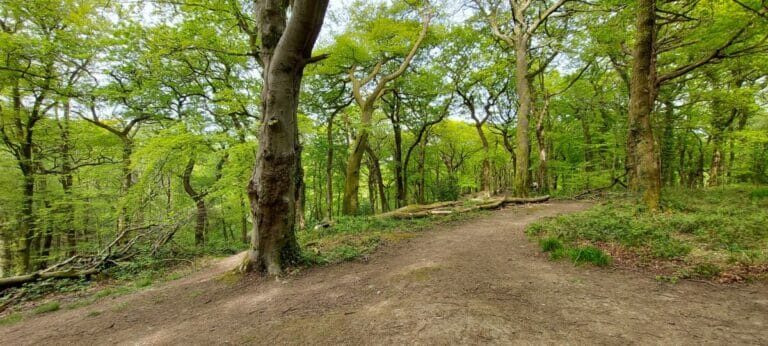Memories of Clyne Valley
Notes from a recorded interview with Dave Stares, formerly of Swansea Council Parks Department. The interview was conducted by BP and PS in Home Farm, Singleton which was the home farm for the Vivian’s estate, on 26 November 2018.
There were railway tracks into this area. The farm was built like an industrial unit.
DS started working in 1982 in Clyne Valley as part of a gang of six. He was the first to be employed there.
His first job was repairing the bridge (copings and abutments ) over a stream along the middle path with David Goss, a stonemason who worked for Parks Department. This path had been a trackway/tramway to bring out coal and or timber.
A YTS scheme was running in the valley while DS was working there; there were 6 to 8 in a team, youngsters who’d finished school – a job creation scheme. They constructed the wooden bridges in the southern end of the valley and the information board (now destroyed by vandals) near the brickworks. DS said the board was a historic interpretation of the brickworks.
There were ‘map tanks’ with a filing system of the Parks but have gone unless they are now held at West Glamorgan Archives. There was a file for Clyne Valley but DS thinks it’s gone.
The brickworks closed in the ‘60s.
The railway had gone and the trackway was tarmac by the time DS started in the valley. His gang did a lot of clearance along the side, removing overhanging branches and ballast. There were still some remains of buildings along the trackside. One building on the east side of the tracks was used by YTS as a mess room but it later burnt down.
The tip was still active but the racecourse had been covered. People used the Mumbles Railway to come into the races. DS used to call it the black track up from Blackpill into the valley. Sometimes he was involved in adding debris to the tip which was a landfill site. DS remembered, as a child in school at Emmanuel, hearing the trucks on the tip (1967–68).
DS was involved in creating the car park at Blackpill which was landscaped to hide the cars from the road. Two houses were demolished before the car park was created.
DS worked on drainage on the middle path and on maintenance of the top path including the fire break around Keeper’s Cottage. This continues today. He was also involved in clearing the rhododendrons. During the winter he would cut down, dig out roots and burn on bonfires and would find lots of old things.
Keepers Cottage caught fire in the mid-1980s.
Today in the valley his department maintains the cycle path, Ynys Newydd playground and the car park.
DS often met John Hayman in the valley.
There were two reservoirs, one beside the top track (with a filter bed) on the east side and one by Mrs Summers’s house at the top of Mill Lane – these provided water for Clyne Castle. He had been into the top track reservoir but it wouldn’t be allowed to today because of health & safety. Cast iron pipes led to the castle. DS remembered seeing a tree blown over and the cast iron pipe through the roots.
They cleared the rhododendrons and camellias from the Ivy Tower out as far as the Common. They had been planted by Admiral Vivian north of the Ivy Tower in squares as trial plantings. Some remain and can be seen in splendour in Spring. Those Vivian approved of were planted in his gardens. DS would have to cut blooms for Ivor Stokes and Julie Bowen to show at RHS shows in London. There are many rare specimens.
DS opened a path up from the middle path; when it was uncovered there were timbers laid down as the base for the path, but a lot had rotted. DS thinks it was laid as a way of extracting timber. Charcoal burners operated on the west side near the claypits. He remembered finding the metal rings and a couple of domes. This was in the area from the winding gear towards the claypits. (This links with Peter Mathew’s memories of the charcoal burners.)
Jimmy Harris’s house was just up from where the Mumbai stands on Mill Lane; he was the son of Harris the nurseries – a local character. Jean Harris was a florist. The nurseries were at the bottom of The Mayals and a piece of land near the prom where the skateboard park is now.
DS had been told that in World War I a deserter lived in an air shaft in the valley.
During World War II a Beaufighter crashed by Ynys Newydd, near the site of the colliery. It was piloted by Sergeant Crummey who is buried in St Hilary’s Church, Killay.
There is a water main under the tip and it goes across the river and up past the Keeper’s Cottage. It’s the main water main for Mumbles.
Mill Gardens was built on Swansea spoil from after the war.
There were hay sheds by the junction of the middle track and Mill Lane.
There was a quarry on the top path providing stone for the roads.
By the Ivy Tower were the remains of Clyne Castle conservatory – they’d been dumped there. DS used large concrete slabs from there to shore up the river in Clyne gardens.
There was a bid by Ivor Stokes for the National Botanic Garden of Wales to be in Clyne Valley but it lost out to Carmarthenshire.
In the late 1980s funding was pulled and no gangs have been funded to work in the valley thereafter.
There is a bomb crater just off the track by Keeper’s Cottage where DS found a German fuse but he discarded it, not knowing what it was at the time. A lot of DS’s gang were ex steelworkers.
